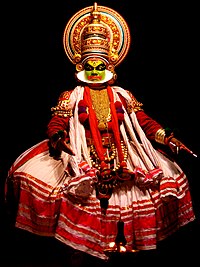Kerala's culture is derived from both a Tamil-heritage region known as Tamilakam and southern coastal Karnataka. Later, Kerala's culture was elaborated upon through centuries of contact with neighboring and overseas cultures. Native performing arts include koodiyattom (a 2000-year-old Sanskrit theatre tradition, officially recognised byUNESCO as a Masterpiece of the Oral and Intangible Heritage of Humanity), kathakali—from katha ("story") and kali ("performance")—and its offshoot Kerala natanam,Kaliyattam -(North Malabar special), koothu (akin to stand-up comedy), mohiniaattam ("dance of the enchantress"), Theyyam, thullal NS padayani. Kathakali and Mohiniattamare widely recognized Indian Classical Dance traditions from Kerala.
Other forms of art are more religious or tribal in nature. These include chavittu nadakom, oppana (originally from Malabar), which combines dance, rhythmic hand clapping, and ishal vocalisations. Margam Kali is one of the ancient round group dance practiced by Syrian Christians of Kerala. However, many of these art forms are largely performed for tourists or at youth festivals, and are not as popular among most Keralites. Contemporary art and performance styles including those employing mimicry and parody are more popular.
Kerala's music also has ancient roots. Carnatic music dominates Keralite traditional music. This was the result of Swathi Thirunal Rama Varma's popularisation of the genre in the 19th century. Raga-based renditions known as sopanam accompany kathakali performances. Melam (including the paandi and panchari variants) is a more percussive style of music; it is performed at Kshetram centered festivals using the chenda. Melam ensembles comprise up to 150 musicians, and performances may last up to four hours. Panchavadyam is a different form of percussion ensemble, in which up to 100 artists use five types of percussion instrument. Kerala has various styles of folk and tribal music. The popular music of Kerala is dominated by the filmi music of Indian cinema. Kerala's visual arts range from traditional murals to the works of Raja Ravi Varma, the state's most renowned painter.
Kolla Varsham or Malayalam Era, which is assumed to have been established by King Udaya Marthanda Varma in 825 AD, serves as the official calendar of Kerala. The Malayalam calendar is used to plan agricultural and religious activities. Kerala's most popular dish is Rice and curry. The sadhya (feast) is traditionally served on green banana leaves. Such dishes as idli, payasam, pulisherry, puttukadala, or PuttuPayarPappadam, puzhukku, rasam, and sambar are typical. Keralites—both men and women alike—traditionally don flowing and unstitched garments. These include the mundu, a loose piece of cloth wrapped around men's waists. Women typically wear the sari, a long and elaborately wrapped banner of cloth, wearable in various styles. Presently, North Indian dresses such as Salwar kameez are also popular amongst women in Kerala.
Elephants are an integral part of daily life in Kerala. Indian elephants are loved, revered, groomed and given a prestigious place in the state's culture. They are often referred to as the 'sons of the sahya.' The ana (elephant) is the state animal of Kerala and is featured on the emblem of the Government of Kerala.
Malayalam literature is medieval in origin and includes such figures as the 14th century Niranam poets (Madhava Panikkar, Sankara Panikkar and Rama Panikkar), and the 17th century poet Thunchaththu Ezhuthachan whose works mark the dawn of both modern Malayalam language and indigenous Keralite poetry. Paremmakkal Thoma Kathanar and Kerala Varma Valiakoi Thampuran are noted for their contribution to Malayalam prose. The "triumvirate of poets" (Kavithrayam), Kumaran Asan, Vallathol Narayana Menon, and Ulloor S. Parameswara Iyer, are recognised for moving Keralite poetry away from archaic sophistry and metaphysics, and towards a more lyrical mode.
In the second half of the 20th century, Jnanpith awardees like G. Sankara Kurup, S. K. Pottekkatt, Thakazhi Sivasankara Pillai, M. T. Vasudevan Nair and O. N. V. Kuruphave made valuable contributions to the Malayalam literature. Later, such Keralite writers as O. V. Vijayan, Kamaladas, M. Mukundan, and Booker Prize winner Arundhati Roy, whose 1996 semi-autobiographical bestseller The God of Small Things is set in the Kottayam town of Ayemenem, have gained international recognition.
Malayalam cinema carved a niche for itself in the Indian film industry. It has been producing both parallel and mainstream cinema of great acclaim for years. Directors like A door Gopalakrishnan, John Abraham, G. Aravindan have been some of the great names in the Indian parallel cinema. Kerala has also given birth to numerous acclaimed actors such as Bharat Gopy, Prem Nazir, Mammotty, Mohanlal, Suresh Gopi, Murali and Oduvil Unnikrishnan.




No comments:
Post a Comment